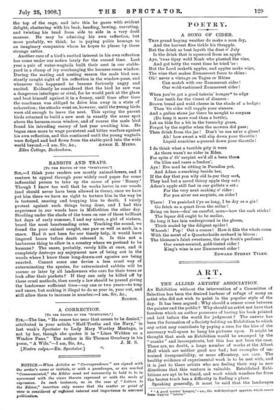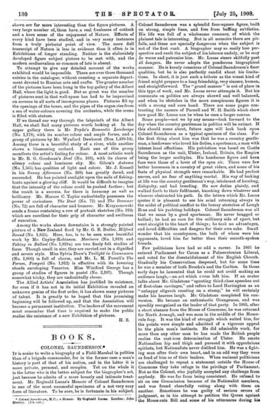ART.
THE ALLIED ARTISTS' ASSOCIATION.
AN Exhibition without the intervention of a Committee of Selection has been the desired harbour of refuge of many an artist who did not wish to paint in the popular style of the day. It has been argued : Why should a censor come between the painter and the public ? Why should an artist not have that freedom which an author possesses of having his book printed and laid before the world for judgment ? The answer has been the formation of a Society holding an Exhibition to which any artist may contribute by paying a sum for the hire of the necessary wall-space to hang his pictures upon. It might be thought that such an Exhibition would be swamped by the " cranks " and incompetents, but this has not been the case. There are, no doubt, a large number of works at the Albert Hall which are neither good nor bad ; but examples of un- trained irresponsibility, or mere effrontery, are rare. The healthy evidence of experimental work is to be met with, and it is just to these artists who are feeling their way in new directions that this venture is valuable. Established Exhi- bitions are apt to be timid, and work which wanders far from the beaten track has a difficulty in finding a place.
Speaking generally, it must be said that the landscapes
* "A good tater& bunger,"—i..., the well-developed appetite which comes from digging ••tatern." _ shown are far more interesting than the figure pictures. A very large number of..-thera havg_a real freshness of outlook and a keen sense of the enjoyment of Nature. Effects et.
. every kind have been studied,. and in .very many instances
from a truly- pictorial- point, of view. • . The .. mere dull transcript Of Nature. is less. in evidence than it often is in Exhibitions of. longer standing. . Neither is the elaborately developed figure subject picture to be met. with, and the
modern mediaevalism so common of late is absent. ,
To attempt to give any detailed account of the 'works exhibited would be impossible. There are over three thousand entries in the catalogue; without counting a separate depart- ment devoted to Russian arts and crafts. The greater numher of the pictures rinive been hung in the top gallery of the Albert Hall, where the light is good. But so great was the number of pictures sent in that wall-space has had to be improvised on screens in all sorts of incongruous places. Pictures fill up the openings of the boxes, and the pipes of the organ rise from a sea of water-colours covering the orchestra, while the arena is filled with statues.
If we thread our way through the labyrinth of the Albert Hall, we shall find many pictures worth looking at. In the upper gallery there is Mr. Pryde's Romantic Landscape (No. 1,178); with its sombre colour and ample forms, and a group of pictures by Mr. Wynford- Dewhurst (Nos. 1,410-14). Among these is a beautiful study of a river, while another shows -a blossoming orchard. Each one of this group manifests the artist's feeling for colour. . A most artistic work is Mr. R. G. Goodman's Deal (No. 168), with its charm of silvery colour and luminous sky. Mr. Gihon's Autumn (No. 1,565) has qualities of light- and colour. Mr. J. Russell in his Sunny Afternoon (No. 268) has greatly dared, and succeeded. He has painted sunlight upon the sails of fishing. boats against a glowing cliff. It would be difficult to imagine that the intensity of the colour could be pushed farther ; but the result is a success, for there is harmony as well as brilliancy. Mr. Horace C. Taylor undoubtedly possesses the power of caricature. The Duet (No. 71) and The Dreamer (No. 72) are full of character and humour. Mr. Krzyzanowski sends a frame containing a row of portrait sketches (-No. 378) which are excellent for their grip of character and swiftness of execution.
Among the works shown downstairs is a strongly painted picture of a New Zealand fiord by Mr. G. E. Butler, Milford Sound (No. 1,825). Here, too, is to be seen some beautiful work by Mr. Cayley-Robinson. Mariners (No. 1,919) and Taking in Ballast (No. 1,919a) are two finely felt studies of form. Though small in size, they are carried out in a dignified and severe style: Miss Sylvia Drew's Twilight in Connemara (No. 1,900) is full of charm, and Mr. L. M. Powell's The Forum, Pompeii (No. 1,912) is effective with its lowering clouds enveloping Vesuvius. Miss Winifred George has a group of studies of figures in pastel (No. 2,197). Though somewhat tricky, they are undoubtedly clever.
The Allied Artists' Association has justified its existence, for even if it has not in its initial Exhibition revealed an unknown genius of the first order, it has shown many pictures of talent. It is greatly to be hoped that this promising beginning will he followed up, and that the Association will become a permanent institution. The leaders of the movement must remember that time is required to make the public realise the existence of a new Exhibition of pictures.
. H. S.







































 Previous page
Previous page